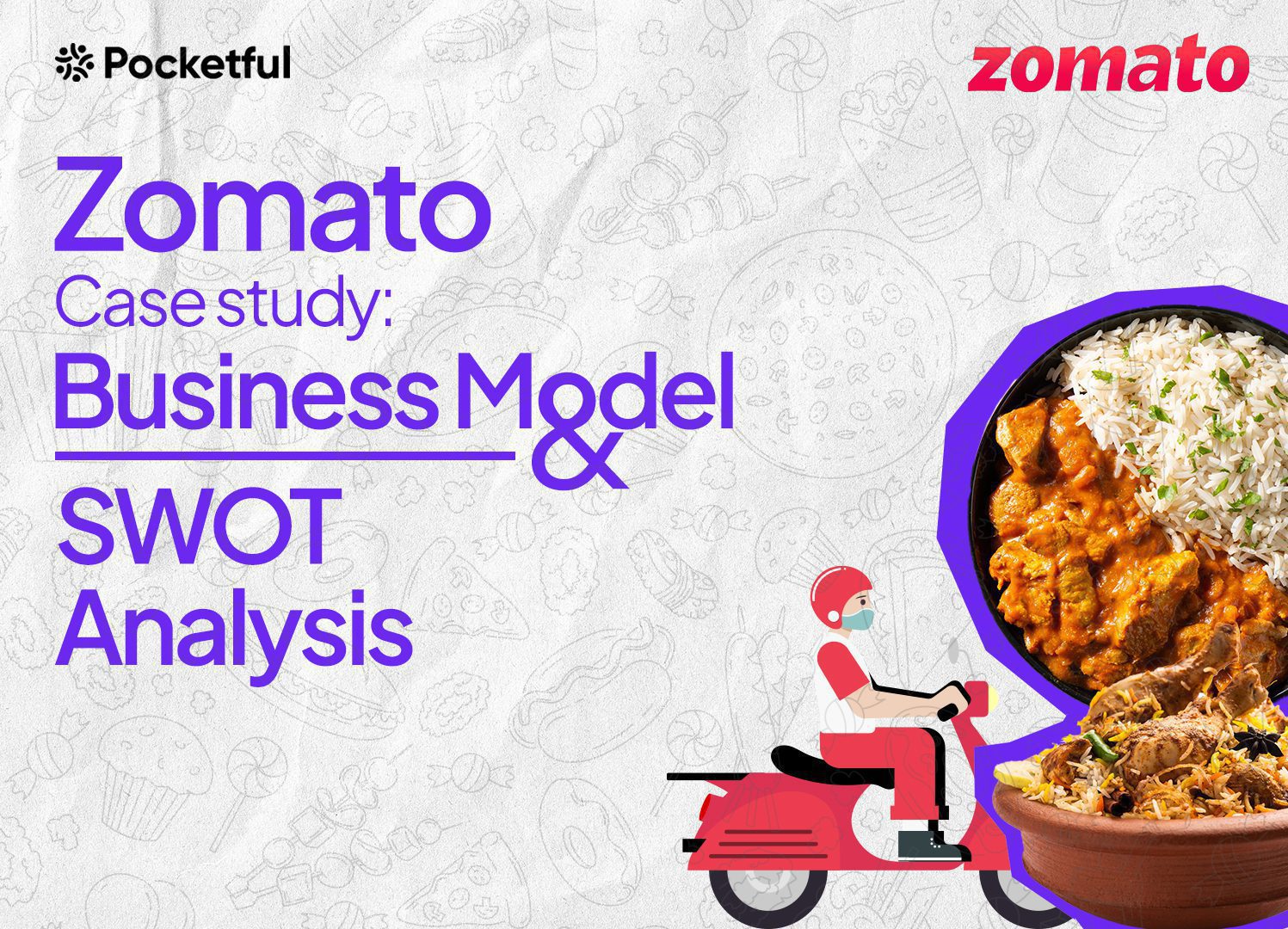| Type | Description | Contributor | Date |
|---|---|---|---|
| Post created | Pocketful Team | Mar-15-24 |

- Blog
- zomato case study business model acquisitions kpis financials and swot analysis
Zomato Case Study: Business Model, SWOT Analysis, and Financials Explained

Everyone knows India’s leading food delivery platform, Zomato. As a pioneering force in the food delivery and restaurant discovery industry, Zomato has revolutionized how people interact with dining options and culinary experiences.
This blog will explain Zomato’s business model, SWOT Analysis, financials, and more.
About Zomato Company
Zomato was founded as FoodieBay in 2008 by Deepinder Goyal and Pankaj Chaddah in Delhi. In 2016, the founders renamed FoodieBay Zomato to appeal to Indian audiences. The company stood out in the marketplace because it provided a comprehensive platform for customers to discover and engage with restaurants.
Zomato was created to solve a common problem – the lack of accessible and organized restaurant information. The company later expanded to food delivery services and has become the most popular food delivery platform in India.
Acquisitions of Zomato
- In July 2014, Zomato acquired MenuMania, a New Zealand-based restaurant database.
- In September 2014, the company acquired Gastronauci, a Poland-based restaurant search service.
- In December 2014, it acquired an Italian restaurant search service named Ciband.
- In 2016, Zomato acquired a Gurgaon-based technology startup, Sparse Labs, and renamed it Zomato Trace.
- In 2018, this company acquired its rival, Uber Eats (Indian operations).
- In 2022, Zomato acquired Blinkit (formerly Grofers).

Shareholders of Zomato
Info Edge India owns the largest share in Zomato. This company is a media and internet firm and owns a 23.9% stake in the company.
Some of the major shareholders in Zomato include:
| Sequoia Capital India | 17.8% |
| Alibaba Ant Financial | 10.8% |
| Temasek Holdings | 7.6% |
| Tiger Global Management | 6.1% |
| Fidelity Management & Research | 5.3% |
Read Also: ICICI Bank Case Study: Financials, KPIs, Growth Strategies, and SWOT Analysis
Did you know?
Deepinder Goyal, the co-founder and CEO of Zomato, owns a 4.3% stake in the company.
Business Model of Zomato
Zomato provides a treasure trove of information, including restaurant names, addresses, contact details, and user-generated reviews and ratings. This helps the audience discover new and unique restaurants.
Zomato utilises the power of the restaurant depository and delivers food orders from these restaurants. Since almost every major restaurant is listed on Zomato, the users’ ability to switch to different apps is drastically reduced. They deliver food quickly to the address of the customer and charge a small fee in exchange for this service.
Segments
Zomato is earning money from a total of 5 segments, they are:
- Food Delivery
- Hyperpure (B2B Supplies)
- Quick Commerce (Blinkit)
- Going-out (Events platform)
- Others

Major Competitors of Zomato
Swiggy
Swiggy is a powerful rival of Zomato, forcing the company to innovate regularly due to the extremely low customer switching cost. As one of Zomato’s primary rivals, Swiggy has cemented its position in the Indian market, posing a strong threat to Zomato’s market share.
Uber Eats
Uber Eats is a company that falls under Uber Technologies and serves 60 countries; it is one of the leading food delivery platforms in the world. Zomato has acquired Uber Eats’ India operations, but Uber Eats still stands as a formidable competitor to Zomato in foreign markets.
DoorDash
DoorDash mainly serves in the United States and Canada. The company has built a reputation for its extensive restaurant partnerships and robust delivery network.
EatClub
EatClub operates in 5 metro cities and has eight brands, such as Box8 and Mojo Pizza. They come across as a very strong contender for Zomato.
Key Data of Zomato
Here is some important market data of Zomato.
| Market Cap | ₹ 1,41,117 Cr. |
| Current Price | ₹ 160 |
| High / Low | ₹ 176 / 49.0 |
| Stock P/E | 122 |
| Book Value | ₹ 25.2 |
| Dividend Yield | 0.00 % |
| ROCE | 0.29 % |
| ROE | 0.20 % |
| Face Value | ₹ 1.00 |
Read Also: Bajaj Finance Case Study: Business Model, Financials, Competitors, and KPIs
Financial Highlights
Income Statement
| Particulars | FY20 | FY21 | FY22 | FY23 |
|---|---|---|---|---|
| Revenue from Operations | 2,604.74 | 1,993.80 | 4,192.40 | 7,079.40 |
| Total Expenses | 4,941.60 | 2,468.90 | 6,062.60 | 8,332.80 |
| EBITDA | -2,336.87 | -475.10 | -1,870.20 | -1,253.40 |
| EBIT | -2,421.10 | -612.8 | -2,020.50 | -1,690.30 |
| Profit before Tax | -2,385.60 | -815.10 | -1,220.50 | -1,014.60 |
| Consolidated Profit | -2,367.16 | -812.8 | -1,208.70 | -971.3 |
Cash Flow
| Particulars | FY20 | FY21 | FY22 | FY23 |
|---|---|---|---|---|
| Cash From Operating Activities | -2,143.63 | -1,017.90 | -693.00 | -844.00 |
| Cash Flow from Investing Activities | 1,735.22 | -5,243.70 | -7,937.80 | 457.30 |
| Cash from Financing Activities | 358.91 | 6,401.90 | 8,749.80 | -127.40 |
| Net Cash Inflow / Outflow | -49.50 | 140.30 | 119.00 | -514.10 |
Profitability Ratios
| Particulars | FY20 | FY21 | FY22 | FY23 |
|---|---|---|---|---|
| ROCE (%) | -142.88 | -18.27 | -9.82 | -5.37 |
| ROE (%) | -200.51 | -21.84 | -10.79 | -5.79 |
| Net Profit Margin (%) | -85.97 | -38.40 | -25.97 | -12.44 |
| ROA (%) | -76.76 | -14.07 | -9.39 | -4.99 |
| EBIT Margin (%) | -92.95 | -30.74 | -48.19 | -23.88 |
Shareholding Pattern
| Shareholder Type | Dec-23 | Sep-23 | Jun-23 | Mar-23 | Dec-22 |
|---|---|---|---|---|---|
| DIIs | 15.47 | 13.04 | 9.93 | 8.03 | 7.43 |
| FIIs | 54.88 | 54.72 | 54.43 | 54.61 | 56.74 |
| Others | 29.65 | 32.24 | 35.64 | 37.36 | 35.83 |
SWOT Analysis of Zomato

Strengths
- Globally available: Zomato expanded its services to various countries and made a global footprint, encouraging international reach and providing access to diverse markets.
- Leading food delivering services: Zomato has become a leader in the food delivery industry. Its food ordering and delivery services cover more than 1,000 cities and have 14.7 million monthly average transacting customers.
Weaknesses
- High Competition – Zomato operates in a highly competitive market, with various food delivery giants like Swiggy, Uber Eats, and EatClub competing for the same customer base.
- Operational challenges – The company faces several operational challenges as a food delivery company, such as delivery delays, food quality issues, and logistical problems. These issues can result in negative customer feedback and reduced customer loyalty, ultimately hurting the company’s profitability.
Opportunities
- Expansion through sustainable practices: The company is capitalizing on the growing demand for sustainable practices by expanding its eco-friendly initiatives.
- Revenue streams: The company diversifies revenue streams and enhances user engagement. Zomato must expand faster than others to stay ahead of the curve.
- New Users: Nowadays, smartphones and internet users have increased tremendously. This will help Zomato gain new users and audiences.
Threats
- Fragile Business model: Economic factors can affect consumer dining and food delivery spending, potentially impacting revenue.
- Loss turning segments: The company loses a significant chunk of money in the Quick Commerce segment and thus has to return lower profits at a consolidated level.
Conclusion
Zomato is building brand recognition, global reach, and user-generated content to contribute to its success in the food delivery industry. Zomato faces lots of challenges, constantly innovating and improving its services to stay ahead of the competition. They must maintain their position and take more initiatives to grow and expand their business.
Frequently Asked Questions (FAQs)
Who is the CEO of Zomato?
Deepinder Goyal heads the company as the CEO.
Is Zomato profitable?
Zomato turned profitable for the first time in the quarter ending June 23. The company produced a profit of INR 2 Crores.
What is the former name of Zomato?
Zomato was founded as FoodieBay in 2008 by Deepinder Goyal and Pankaj Chaddah.
How many segments does Zomato report?
Zomato has 5 segments, namely – Food Delivery, Hyperpure, Quick Commerce, Going-out, and Others.
Is Zomato used outside India?
The company is operational in Indonesia, Sri Lanka, and UAE.
Disclaimer
The securities, funds, and strategies discussed in this blog are provided for informational purposes only. They do not represent endorsements or recommendations. Investors should conduct their own research and seek professional advice before making any investment decisions.